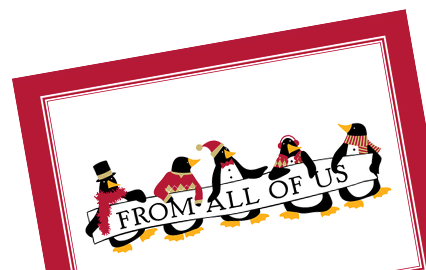Nov 2nd 2023
How to Categorize Greeting Cards for Clients: Tax Tips for Your Business
As business owners, we understand the importance of maintaining good relationships with our clients. One way to do that is by sending them greeting cards for special occasions or just to say thank you. However, we also know that keeping track of our business expenses is essential, especially when it comes to tax season.
So, how do we categorize greeting cards for clients for tax purposes?It's essential to know how to categorize these expenses to ensure we're accurately reporting and claiming tax deductions. Greeting cards can be considered a business gift, and as such, there are rules and limitations when it comes to claiming them as a tax deduction.
In the United States, the IRS allows us to deduct up to $25 per person, per year for client gifts, including greeting cards (source). It's crucial to keep detailed records of our client gifts, including the cost, date, and recipient, to make sure we stay compliant and take advantage of these allowable deductions.
Understanding Business Expenses

We know that managing business finances can be a complicated task, and it's essential for us to understand various business expenses and their tax implications. Business expenses play a significant role in determining deductions that can be claimed on our taxes.
First, let's explore the concept of business expense categories. Business expenses can be categorized into different areas, such as utilities, travel, wages, and rent. By categorizing our expenses, we can better understand and manage our spending habits, which ultimately benefits our financial planning and the well-being of our business.
Now, let's focus on an expense that's often overlooked: greeting cards for clients. These expenses may seem insignificant, but they can add up over time and should be factored into our tax strategy. To categorize greeting cards, we have a few options. One possible category is advertising and promotional expenses since greeting cards can help maintain client relationships and promote our business.
It's important for us to be aware of which expenses are deductible and which are not. Deductible expenses are those that are considered "ordinary and necessary" for running our business. Generally, we can deduct advertising and promotional expenses if they are relevant and reasonable. Therefore, the cost of purchasing and sending greeting cards to clients can potentially be deductible if we categorize them under the advertising and promotional expenses category.
Remember, the more accurately we categorize our business expenses, the more effectively we can claim deductions on our taxes and manage our finances. So, take the time to review and categorize all our expenses, including greeting cards for clients, to ensure we're making the most of our tax strategy.
The IRS and Deductions
As a business owner, we understand that categorizing greeting cards for clients can be confusing when preparing for tax season. The IRS has specific guidelines regarding what can be considered as a tax-deductible expense, and this includes business gifts, which may encompass greeting cards.
According to the IRS, gifts given to clients in the course of a business can be considered tax-deductible expenses. However, there is a limit. Under the Tax Cuts and Jobs Act, businesses can deduct up to $25 per recipient per year for gifts. So, if you're giving a greeting card that falls within this limit, it would be considered a tax-deductible expense.
When it comes to gift cards or gift certificates, the IRS treats them differently. Since they have a monetary value, they cannot be considered as a business gift under the same $25 rule. Instead, gift cards or certificates provided to clients should be categorized as taxable income on your tax return.
Here are some tips for categorizing these expenses:
- Greeting cards: If their value is under the $25 limit, include them as a tax-deductible business gift expense on your tax return.
- Gift cards or certificates: These should be categorized as taxable income for your clients since they have a monetary value.
Keep in mind that thorough documentation is key. We recommend maintaining detailed records of your gift expenses, including receipts and the names of the clients who received the gifts. This will help ensure your tax return is accurate and make filing a breeze.
Remember, while greeting cards and gift cards may seem like minor expenses, properly categorizing and documenting them is essential for staying in compliance with IRS regulations and maximizing your tax-deductible expenses. So, be diligent with your records and consult a tax professional if you have any doubts or questions. Happy gifting!
Categorizing Greeting Cards for Clients
As a small business, it's important to maintain strong relationships with our clients. Sending greeting cards for different occasions, such as holidays or birthdays, can be an effective way to keep the connection alive. However, to make the most out of this practice, we need to correctly categorize these expenses for tax purposes.
In general, greeting cards sent to clients can be classified as a marketing or advertising expense. This includes not only holiday cards, like Christmas and other seasonal greetings, but also cards meant to express gratitude, celebrate a milestone, or build loyalty. By recording this expense under marketing, we can ensure that it counts as tax-deductible within allowable limits, thus helping us to manage our taxes more effectively.
For some specific occasions, such as giving cards that incorporate certificates or rewards, we might need to handle them differently. In cases where a card contains tangible incentives, like gift cards or discount vouchers, we should categorize the value of those items separately as a promotional expense. This will not only help us monitor the costs of our promotional efforts but also keep our accounting records more organized.
As small business owners, it's essential to understand these distinctions in order to take full advantage of allowed tax deductions and stay compliant with regulations. By categorizing client greeting cards properly, we not only build stronger connections with our clients but also optimize our budget and maintain a financially healthy business.
Remember that besides sending custom greeting cards, we should continuously explore other ways to connect and engage with our clients, ensuring their satisfaction and loyalty towards our business. Achieving a balance between effective relationship-building techniques and efficient expense management is the key to our small business' long-term success.
Shipping and Packaging Expenses

As a business, we understand the importance of properly categorizing our expenses for tax purposes. One area that might require our attention is the expenses related to sending greeting cards to clients. This includes expenses like shipping, packaging, and gift wrapping, which sometimes can be overlooked when categorizing business expenses.
When it comes to shipping costs, it's essential to track the amount we spend on sending greeting cards to clients. We can do so by carefully monitoring our postage costs, courier fees, and any other shipping-related expenses. By accurately recording these costs, it will make it easier for us to claim these expenses on our taxes.
In addition to shipping costs, packaging expenses must also be considered. Packaging materials like envelopes, boxes, and protective padding are essential to ensure our greeting cards reach our clients safely and in good condition. It's crucial to maintain records of the costs associated with purchasing these materials, as they can be deducted as business expenses as well.
Lastly, if we choose to add a personal touch to our greeting cards sent to clients by offering gift wrapping services, it's essential to account for any costs associated with this service. Gift wrapping materials, such as wrapping paper, ribbons, and decorative elements, should be treated as a separate business expense. It's best to maintain clear records of these expenditures to make the process of filing our taxes more manageable.
Overall, it's crucial to stay organized when tracking and categorizing expenses related to shipping, packaging, and gift wrapping for the greeting cards we send to our clients. By doing so, we'll have a more precise understanding of our business expenses, and we can ensure that we're maximizing our tax deductions.
Entertainment Expenses
As a business, we should be aware of the tax implications associated with entertainment expenses, such as sending greeting cards to our clients. Entertainment expenses can include various activities like concerts, sporting events, and other forms of social engagement, which businesses use to build relationships with clients and potentially generate more revenue.
When it comes to classifying greeting cards for clients in the entertainment expenses category, we must keep in mind that the IRS has clear rules and limitations on tax deductions for such costs. Generally, businesses can deduct only 50% of the expenses related to meals and entertainment. However, it is essential to distinguish between meals and pure entertainment expenses.
Greeting cards, in particular, fall under the business gift tax rules. According to the IRS, business gifts given to clients must not exceed $25 per person per year to be considered tax-deductible. Moreover, it is crucial to track such gifts, as indirect gifts also count towards the $25 limit per client. Bear in mind that entertainment expenses like tickets to concerts or sporting events may incur different deductibility percentages and limitations than other types of client gifts.
To make the most of the allowable tax deductions, it is essential for us to keep detailed records of our entertainment expenses and gifts to clients. We should document the date, type, and cost of each expense, along with the client's information and the purpose of each event. This thorough record-keeping allows us to manage our tax deductions more effectively and stay compliant with IRS regulations.
In summary, categorizing greeting cards for clients as entertainment expenses for tax purposes requires understanding the IRS rules for both entertainment expenses and business gifts. By being diligent about our record-keeping and staying informed of the current tax laws, we can ensure that our business maximizes deductions while maintaining compliance with the IRS.
Meal and Travel Expenses
When we run a business, it's essential to stay on top of our tax obligations, including properly categorizing expenses. One important aspect to consider is meal and travel expenses. Let's dive into how we can effectively categorize these expenses to help streamline our business's tax preparation process.
First, let's discuss the meals we provide for our clients. When we treat clients to lunch or dinner, the cost falls under the business meals category. The IRS allows us to deduct 50% of these meal expenses, assuming they meet specific criteria. To be deductible, business meals must be ordinary, necessary, and directly associated with the active conduct of our business. Between December 31, 2020, and January 1, 2023, there is a temporary 100% deduction for food or beverages provided by a restaurant.
Now, let's tackle travel expenses. Traveling for business purposes is another common expense for meeting with clients and attending events. Travel expenses include transportation, lodging, and incidental expenses like laundry and tips. We must ensure that we only deduct travel expenses that are directly related to our business, and keep detailed records of the purpose and cost of each trip. It's essential to separate any personal activities during our business trips, as the IRS doesn't allow deductions for personal travel expenses.
When it comes to travel meals, we can also deduct 50% of the cost of meals while on a business trip. Similar to the rules for business meals, we need to confirm that the meals are ordinary, necessary, and directly associated with the active conduct of our business. Keep in mind that self-employed individuals can use the IRS per diem meal rates, while employees can only use the travel per diem for lodging expenses (source).
By understanding how to properly categorize and track our meal and travel expenses, we can take full advantage of the tax deductions available. This will help to minimize our tax liability and ensure that our business operates smoothly and efficiently.
Record Keeping for Deductible Expenses
We understand how important it is to properly categorize greeting cards for clients for tax purposes. To help you with this process, let us discuss some essential tips for record keeping.
First, it's necessary to maintain accurate and organized records of your deductible expenses. Having a separate folder or binder for your greeting cards can go a long way in keeping things in order. You may also consider creating a spreadsheet or using accounting software to log and track your expenses.
As a business owner, it's essential to familiarize ourselves with the concept of ordinary and necessary expenses. According to the IRS, an expense must be both ordinary and necessary to be tax-deductible. In the case of greeting cards, if they are a regular part of your client relationship-building strategy or used to generate business, they could be considered both ordinary and necessary expenses.
Here's a quick breakdown of how to classify greeting card expenditures effectively:
- Purchase cost: If you're buying greeting cards in bulk, record the total purchase cost.
- Printing charges: If you're customizing cards for your clients, include any printing charges.
- Postage fees: Don't forget to include the cost of mailing the cards to your clients.
When tracking these expenses, be sure to note the date, amount, and purpose of each expense. Consistently updating and tracking this information will help in managing your deductible expenses and ensure that you're prepared for tax season.
In a nutshell, proper record keeping for deductible expenses, including greeting cards, is crucial to help save money on taxes and maintain strong client relationships. Stay organized, utilize appropriate tools, and always stay informed about the IRS guidelines to ensure that your business remains compliant and financially healthy.
Rent, Utilities, and Office Expenses

When it comes to running a business, categorizing expenses is essential for tax purposes. Rent, utilities, and office expenses like greeting cards for clients are a few categories that are important to keep track of. In this section, we'll discuss how to organize these expenses to make tax time a breeze.
Rent is typically a significant expense for most businesses. It's essential to record rent payments accurately and consistently. This ensures that business owners can claim the appropriate deductions on their tax return. If we rent a location specifically for storing greeting cards or holding events with our clients, those expenses can be classified as rent too.
Utilities are another critical category in business expense management. This includes electricity, water, gas, and internet services for our office. It's crucial to track utility expenses separately, as they are also deductible. For example, if our office uses a significant amount of electricity to power a printing machine for creating greeting cards, we should record that expense under utilities.
Office expenses encompass various items that help keep our business running smoothly. This category includes office supplies, such as paper, pens, and envelopes. It's essential to separate office supplies expenses from other categories since these expenses are tax-deductible, as well.
When it comes to categorizing greeting cards for clients, they can be considered an office expense or marketing expense, depending on the business's purpose. If we use greeting cards as a means of marketing our services or products, we could classify them as a marketing expense. Alternatively, if our primary reason for sending greeting cards is to maintain relationships with clients, they can be considered an office expense.
By staying organized and carefully tracking our rent, utility, and office expenses, we can effectively manage our finances and simplify the tax filing process. This practice will ultimately save time and contribute to our business's success. Remember, it's always a good idea to consult with a professional accountant for clarifications and advice on categorizing specific expenses for our business.
Deductions beyond the $25 Limit

When it comes to recorded gifts for our business, we find ourselves facing the infamous $25 limit for tax deductions. As many of you know, this rule has remained unchanged since 1962. While it might seem outdated, it's essential for us to adhere to this regulation, regardless of how small that amount feels today. Luckily, there are a few exceptions to this rule that can help us when categorizing greeting cards for clients.
First of all, we need to understand that tangible items count as business gifts. It means that we don't need to worry about the cost of basic greeting cards themselves. Generally, these cards come way under the $25 threshold, so we're in the clear.
Now, if we decide to add some extra goodies alongside our greeting cards, we must consider their combined value. Remember, if it's over the limit, we won't be able to take full advantage of the tax deductions. But, here is the good news: incidental costs are excluded from the $25 cap. Incidental costs include expenses like gift-wrapping, shipping and handling, or engraving, which don't add intrinsic value to the gift.
Additionally, let's discuss employee gifts and compensation. If we offer a gift as part of our employee's compensation package, it's crucial to categorize it as such. These gifts are usually subject to payroll taxes, although they are tax-deductible as compensation expenses. Therefore, they don't fall under the restrictions of the $25 limit, meaning a more generous token of appreciation is possible.
While each case may vary, the important thing is for us to be clear about the purpose behind our gifts and maintain proper records of these expenses. As long as we keep things accurate and reasonable, we'll be able to make the most of those tax deductions while expressing our gratitude towards our clients and employees.
Frequently Asked Questions
What are the IRS guidelines for categorizing client gifts?
The Internal Revenue Service (IRS) has specific guidelines when it comes to categorizing client gifts for tax purposes. According to the IRS, if you give business gifts in the course of your trade or business, you can deduct all or part of the costs, subject to certain limitations.
How should I record gift expenses in accounting?
When it comes to recording gift expenses in your accounting, it's essential to maintain clear and organized records. Ensure that you have a separate expense account for business gifts, and diligently document each transaction, including the recipient's name, the purpose, and the gift's value.
What's the limit for tax-deductible business gifts in 2023?
For tax year 2023, the IRS allows you to deduct no more than $25 of the cost of business gifts you give directly or indirectly to each person during your tax year. If you and your spouse both give gifts to the same person, both of your gifts are treated as being given by one person.
Are gifts to family members considered business expenses?
Gifts to family members can be considered business expenses if the family member is a client, customer, or employee, and the gift meets IRS guidelines for deductibility. However, be cautious when giving gifts to family members, as the IRS may scrutinize these transactions closely to ensure they qualify as legitimate business expenses.
How do I categorize gift cards given to clients?
Gift cards given to clients can be categorized as business gifts for tax purposes. Record the transaction in your accounting just as you would for any other business gift, including details about the recipient, the purpose of the gift, and the card's value. Remember to adhere to the IRS's guidelines and limitations for business gift deductions.
Which IRS business expense category should I use for client gift?
When you file your taxes, you should report your client gifts under the "gifts" expense category. This category falls within the broader "business expenses" section on your tax return. Be sure to provide accurate and complete information, as the IRS might audit your return if it finds inconsistencies or errors.


 Business
Business
 Personalized
Personalized
 Holiday
Holiday
 Customer
Customer
 Bulk
Bulk
 Birthday
Birthday
 Thank You
Thank You
 Anniversary
Anniversary
 Sympathy
Sympathy
 Retirement
Retirement
 Christmas
Christmas
 Thanksgiving
Thanksgiving
 New Year
New Year
 Hanukkah
Hanukkah
 Rosh Hashanah
Rosh Hashanah
 Appreciation
Appreciation Merry Christmas
Merry Christmas Happy Holidays
Happy Holidays Seasons Greetings
Seasons Greetings Funny Cards
Funny Cards Religious
Religious Peace
Peace Patriotic
Patriotic Accounting
Accounting Finance
Finance Photo Cards
Photo Cards Foil Cards
Foil Cards Laser Cut Cards
Laser Cut Cards Die Cut Cards
Die Cut Cards Front Imprint
Front Imprint Recycled Cards
Recycled Cards New York
New York San Francisco
San Francisco Chicago
Chicago Los Angeles
Los Angeles Houston
Houston By Animal
By Animal Christmas Tree
Christmas Tree Western/Southwestern
Western/Southwestern Tropical/Beach
Tropical/Beach Winter Scenes
Winter Scenes Budget Cards
Budget Cards Legal
Legal Construction
Construction Real Estate
Real Estate Trucking
Trucking Accounting
Accounting Holiday Phrases
Holiday Phrases







 Fully Custom
Fully Custom  Friendly
Friendly A portion of every card purchased is donated to charity.
A portion of every card purchased is donated to charity.
 Proudly Made
Proudly Made